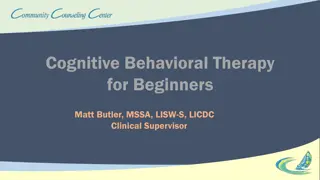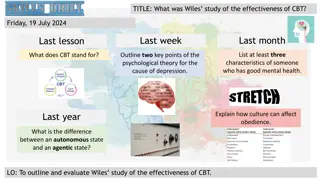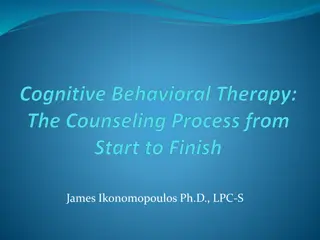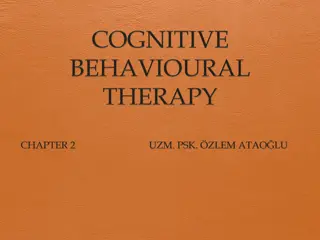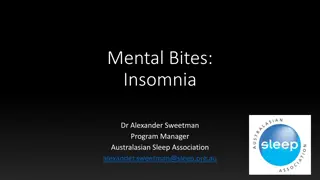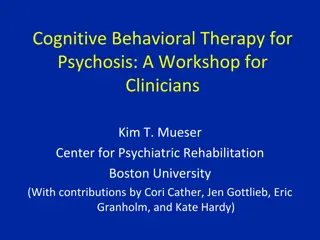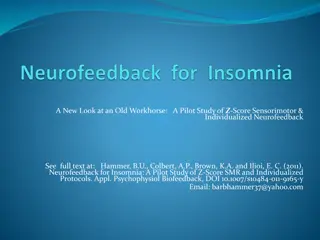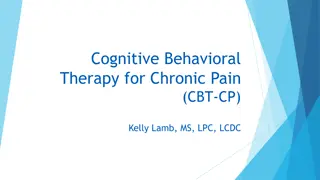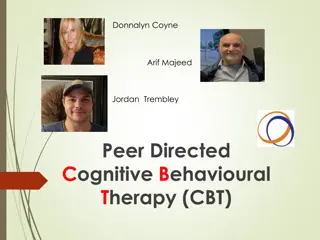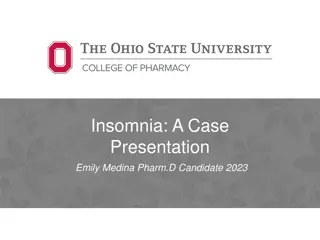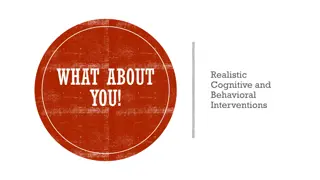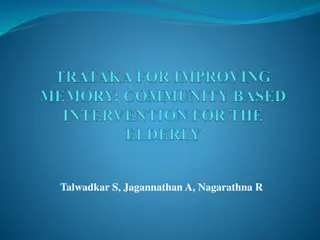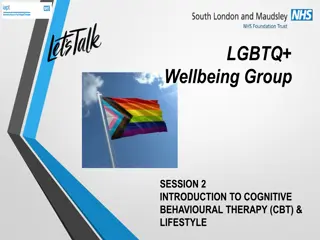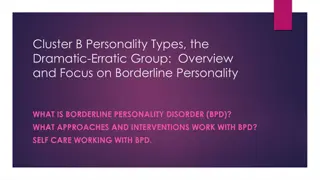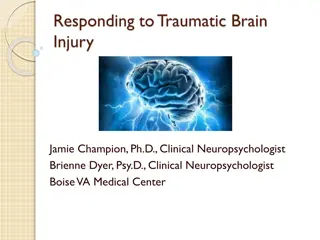Understanding Cognitive Behavioral Therapy for Insomnia (CBT-I)
Cognitive Behavioral Therapy for Insomnia (CBT-I) is a structured and evidence-based treatment aimed at replacing thoughts and behaviors that disrupt sleep with healthier habits. This approach helps address the underlying causes of sleep problems. The content explores the basic principles, techniques, assessment components, and exclusionary criteria of CBT-I, along with a case study for practical application. Additionally, it defines insomnia, its clinical criteria, and provides insights into the history of sleep patterns in humans.
Download Presentation

Please find below an Image/Link to download the presentation.
The content on the website is provided AS IS for your information and personal use only. It may not be sold, licensed, or shared on other websites without obtaining consent from the author. Download presentation by click this link. If you encounter any issues during the download, it is possible that the publisher has removed the file from their server.
E N D
Presentation Transcript
Cognitive Behavioral Therapy for Insomnia (CBT-I) Presented by Dr. Brooke A. Donald, licensed psychologist
Learning Objectives: Learning Objectives: Describe the basic principles of CBT-I Learn the assessment component of CBT-I. Describe the basic techniques of CBT-I (Stimulus control therapy, sleep restriction, sleep hygiene) Describe the exclusionary criteria for CBT-I Review a case study to enhance learning objectives.
What is CBT-I Cognitive behavioral therapy for insomnia (CBT-I) is a structured, evidence- based treatment. The goal of CBT-I is to identify and replace thoughts and behaviors that cause or exacerbate sleep problems with habits that promote sound sleep. CBT-I helps overcome the underlying causes of sleep problems. Today we will explore what insomnia is and then look at CBT-I
Insomnia is a glorious term for thoughts you forgot to have during the day -Alain De Bottom
Fun Fact Humans are the ONLY being known to willingly (on purpose) delay sleep, recent phenomena, about 100 or so years ago, nearly everyone got nine or more hours of sleep per night Then, electric lights became common, allowing us to stay up late in the light rather than in the dark In the 40s and 50s, television kept us up late at night Internet in the 1990s and 2000s
What is Insomnia? Typically refers to an individual s self report of having difficulty with sleep. difficulty falling asleep difficulty staying asleep
Clinical Definition of Insomnia Clinical definition of sleep (diagnostic criteria) ICD-10 G47.00/DSM-V F51.01 (1) difficulty falling asleep, remaining asleep or nonrestorative sleep (not feeling rested after a night's sleep) (2) this difficulty is present despite adequate opportunity and circumstance to sleep (3) this difficulty with sleep is associated with daytime impairment or distress (falling asleep easily while sitting, difficulty concentrating, increased distress around not being able to sleep) (4) this sleep difficulty occurs at least 3 times per week and has been a problem for at least 1 month.
Facts about Insomnia Roughly 30% of general population suffer from insomnia Those who suffer from insomnia are more prone to accidents Increase in work absenteeism Decrease in job performance Decrease in quality of life Increase in health utilization
Costs of Insomnia in the US Estimates of total insomnia-related costs in the United States have ranged from $30 to $35 billion per year to $92.5 to $107.5 billion per year. direct treatment costs, such as physician encounters and prescriptions and indirect costs, utilization of medical services, increased accident risk, and lost workplace productivity.
Risk Factors Associated with Insomnia Age Gender (menopause) Presence of co-morbid medical condition Psychiatric disorders (depression and anxiety) Shift work or rotating work schedule Chronic illness (GERD, pain, restless leg, sleep apnea)
What we know Insomnia is a disorder of hyperarousal, which is experienced throughout the day (40% of patients with insomnia also have anxiety) Hypervigilance/hyperarousal is both cognitive and physiological (can be measured by way of VO2 oxygen levels, cortisol excretion and PET Scans people with insomnia have a higher metabolic rate i.e. consume more oxygen, secrete more cortisol and have more cerebral glucose metabolized) Corticotropin releasing factor (CRF) neuropeptide is a major regulator of the hypothalamic pituitary adrenal system and is involved in stress response
How Can We Help When an unproductive worry about a life event shifts to a worry about sleep, this is where Cognitive Behavioral Therapy for Insomnia can help
What is CBT-I Is an approved, empirically valid, method for treating insomnia Since 2016 is now recommended by the American Board of Physicians as the first line of treatment for insomnia Studies have shown CBT-I is more affective than medication for sleep. CBT-I does not involve medication for sleep CBT-I helps a person change sleep habits and thoughts about sleep that perpetuate sleep difficulties Use of a sleep diary to create a base line of sleep patterns in order to adjust and retrain the brain to fall asleep and stay asleep, you can graph the weeks to show patient that the time in bed is getting closer to the time asleep and that is a major goal of retraining the brain to sleep when in bed Involves sleep restriction or sleep consolidation (reduce time in bed for when actually asleep and never less than 5.5 hours) and stimulus control developed by Arthur Spielman
Arthur Spielman and the 3-P Model of Insomnia Predisposing factors: biological, psychological and social traits Precipitating factors: onset of acute illness or stressor Perpetuating factors: maladaptive strategies used to compensate for loss of sleep that keeps person from sleeping (dysfunctional beliefs, attitudes and behaviors about sleep)
CBT-I - Scales Use of scales: Epworth Sleepiness Scale Insomnia Severity Index Dysfunctional Beliefs and Attitudes About Sleep PHQ9 and GAD 7 Mood Disorder Questionnaire
Components of CBT-I Therapy involves a combination of psychoeducation about sleep (role of caffeine, alcohol and nicotine, role of light and exercise, maintaining daytime alertness, dark bedroom, avoid clock watching, explaining sleep cycle) and sleep hygiene (set bedtime and wake up time, get out of bed if not asleep, no daytime napping, bedroom only for sleep and sex, only going to bed when tired Sleep diary (this is used weekly to calculate sleep efficiency=time in bed should be close to time asleep). sleep restriction therapy stimulus control therapy and cognitive therapy to decrease the rumination about sleep as well as relaxation training
Exclusionary Criteria For CBT-I Chronic Pain Bipolar I Manic Orthostatic hypertension Untreated sleep apnea (must be using CPAP machine) Designed for adults Adults who work night shifts
Case study 56-year-old, married, Caucasian male, executive at major firm in tri-state area, two children in their twenties, youngest, 26-year-old living at home. Predisposing factors (history of anxiety, family history of anxiety) Precipitating factors (recent acute stressors at work being passed over for a promotion, not feeling like he could grasp the new technology and at home with his son not being able to move out) Perpetuating factors (would take a nap when he got home from work at 7 pm, then work out and then eat dinner and would not be able to fall asleep until 1 am) Reported no major health concerns, was a long-distance runner, recently hurt knee and had to stop running Reported problems with sleep with abrupt on set, sleep diary revealed 5 hours of sleep, his scored a 15 on Epworth sleepiness scale, above normal level of sleepiness during the day, he scored a 22 on the Insomnia Severity Index, he scored an average of 7 on the DBAS, indicating his thoughts about sleep might be impacting his ability to fall and stay asleep, PHQ9 was 7 and GAD 7 was 15 and MDQ was negative screen for bipolar, would not adjust sleep patterns, would not adhere to set bed time and wake up time, would not follow sleep restriction or stimulus control recommendations . . . .
References Anderson, Kristie (2018), Insomnia and Cognitive Behavioral Therapy-How to Assess Your Patient and Why it Should be a Standard of Care. Journal of Thorasic Disease, Jan; 10 s94-s102. Court, Maria (2019), Insomnia: Long Distance CBT as Effective as In-Person Therapy. Medical News Today. [Electronically Retrieved 9-4-19]. Levensson, Jessica C., Kay, Daniel B, & Buysee, Daniel, J. (2015), The Pathophysiology of Insomnia . The American College of Chest Physicians, Elsevier Inc. Lamberg, L. (2016). Behavioral Therapy May Be Superior to Zolpidem for Chronic Insomnia. Published online September 16, 2016, psychnews.psychiatryonline.org/doi/full/10.1176/appi.pn.2016.pp864 Roth, T. (2007). Insomnia: Definition, Prevalence, Etiology and Consequences. Journal of Clinical Sleep Medicine. Aug 15; 3(5 Suppl); S7-S10. Wickwire, E. (2014). The final cost of insomnia. Journal of Sleep Review, 12-2- 2014. https://www.icd10data.com/ICD10CM/Codes/G00-G99/G40-G47/G47-/G47.00
Link to Scales Epworth Sleepiness Scale https://www.edsandosa.com/static/media/epworth-sleepiness-scale-ess.pdf Insomnia Severity Index https://www.ons.org/sites/default/files/InsomniaSeverityIndex_ISI.pdf Dysfunctional Beliefs and Attitudes About Sleep Scale http://www.cets.ulaval.ca/sites/cets.ulaval.ca/files/dysfunctional_beliefs_and_attitudes _about_sleep_30_items.pdf PHQ9 and GAD 7 https://www.med.umich.edu/1info/FHP/practiceguides/depress/phq-9.pdf https://www.integration.samhsa.gov/clinical-practice/gad708.19.08cartwright.pdf Mood Disorder Questionnaire http://www.sadag.org/images/pdf/mdq.pdf * Not hyperlinks, will have to cut and paste into web browser


